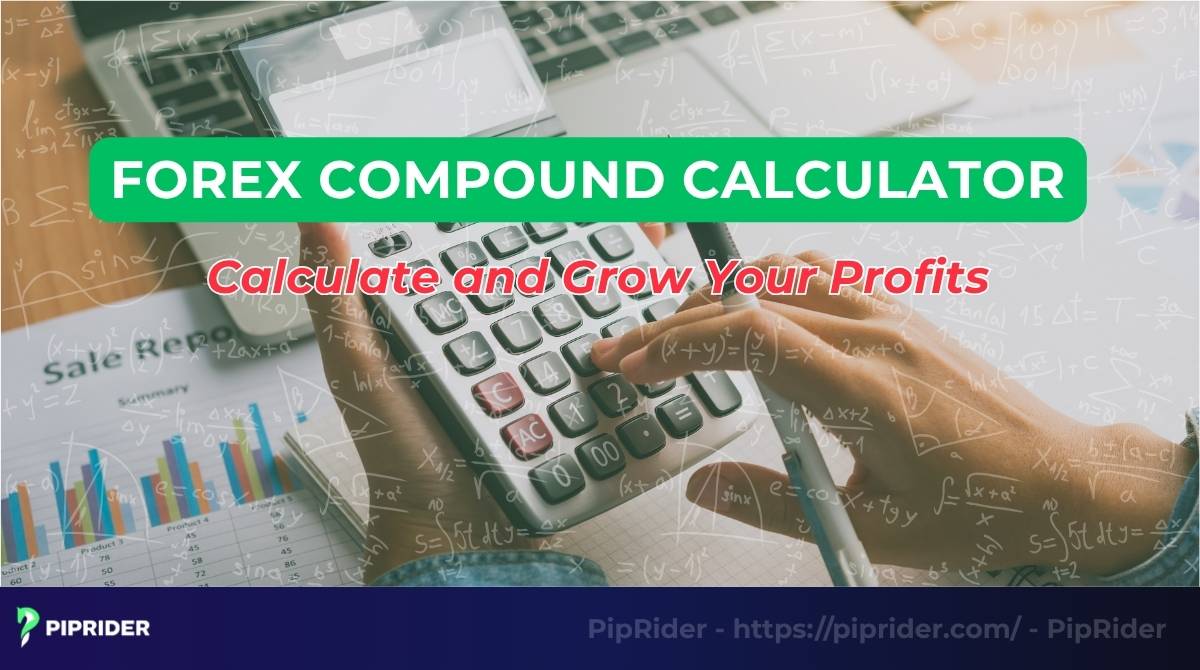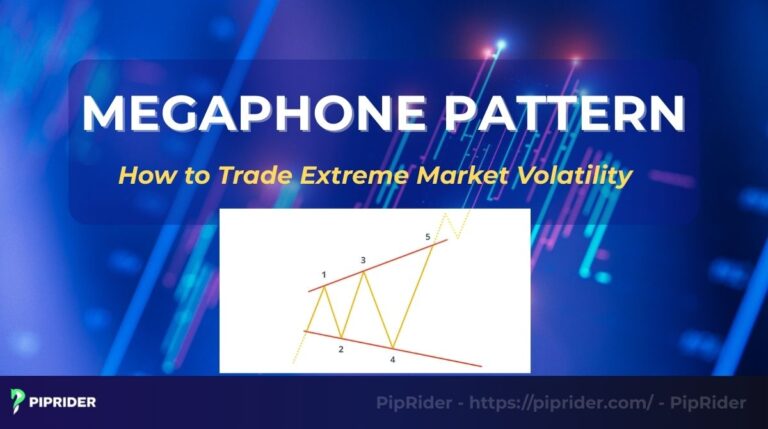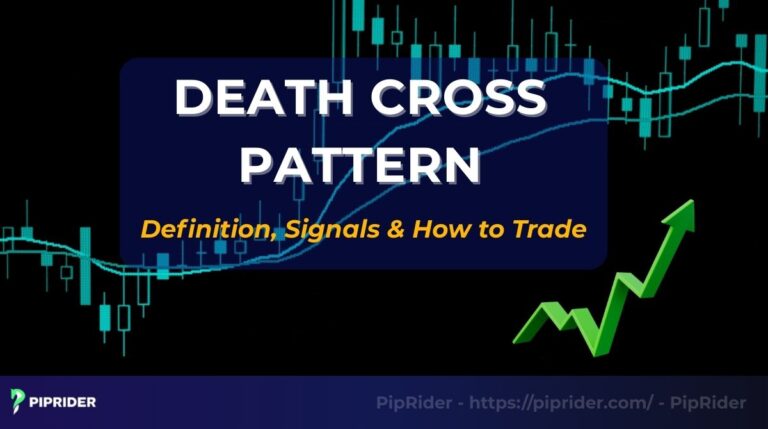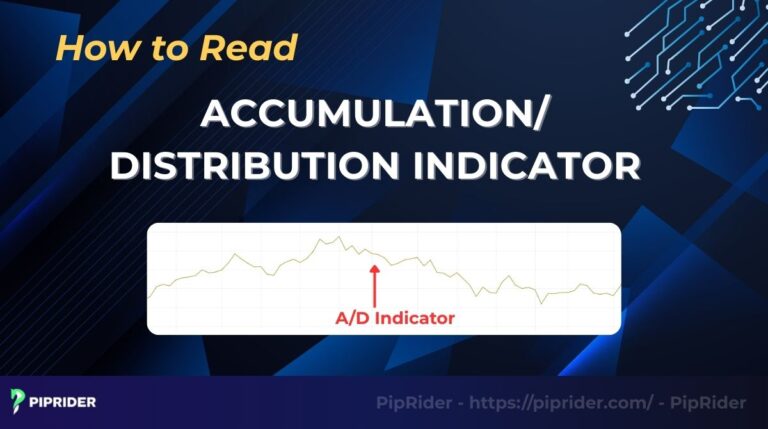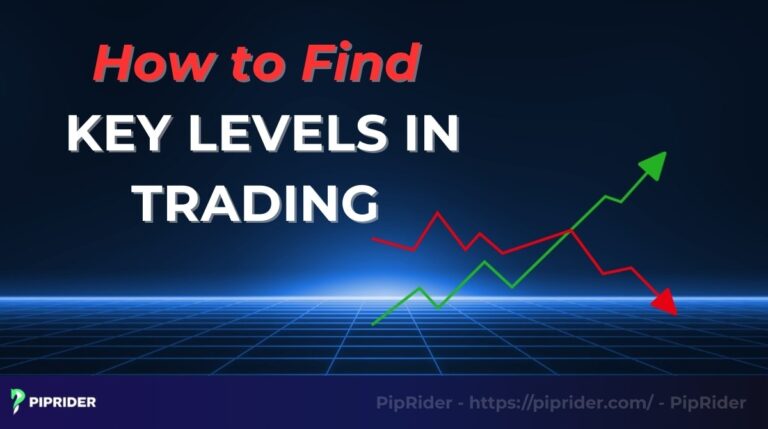Compounding is the process of generating earnings from previously reinvested earnings, resulting in exponential capital growth in a trading account. While many traders concentrate solely on the outcome of a single trade, successful professionals prioritize the long-term impact of consistently reinvesting gains.
This guide explains the objective principles of compounding in the financial market, and the powerful forex compound calculator is designed to help you quantify and visualize that full growth potential.
Key Takeaways
- A forex compound calculator is a tool that projects how an account can grow by reinvesting profits over time.
- It functions as a trading compound interest calculator, demonstrating how consistent percentage gains can lead to exponential growth.
- The calculation requires key inputs: a starting balance, an estimated percentage return per period, and the number of periods (days, weeks, months).
- Using this tool helps traders set realistic long-term goals and visualize their potential capital growth.
- It provides a clear forecast, similar to a forex interest calculator, but focused specifically on trading gains rather than earnings on a savings account.
1. What Is a Forex Compound Calculator?
A forex compound calculator is a powerful planning tool that shows how a trading account can grow exponentially over time. By inputting a starting balance, a consistent profit percentage, and a number of periods, traders can see a detailed projection of their potential future account value.

It differs from a simple profit calculator, which only calculates the outcome of a single trade. A forex compounding calculator simulates the process of reinvesting profits, showing how gains from one period become part of the capital that generates gains in the next period.
Compounding is a critical concept in foreign exchange. Many professional strategies are built around achieving consistent, repeatable percentage gains rather than large, random wins. This tool helps traders understand the long-term impact of that consistency and allows them to set realistic, motivating financial goals for their currency trading (Market Bulls, n.d.).
2. How Forex Compounding Works
The principle behind the calculator is compound interest. In forex trading, this means reinvesting profits from winning trades back into an account, allowing a trader to gradually increase their trade size and accelerate capital growth.
2.1. The Difference: Simple vs. Compound Growth
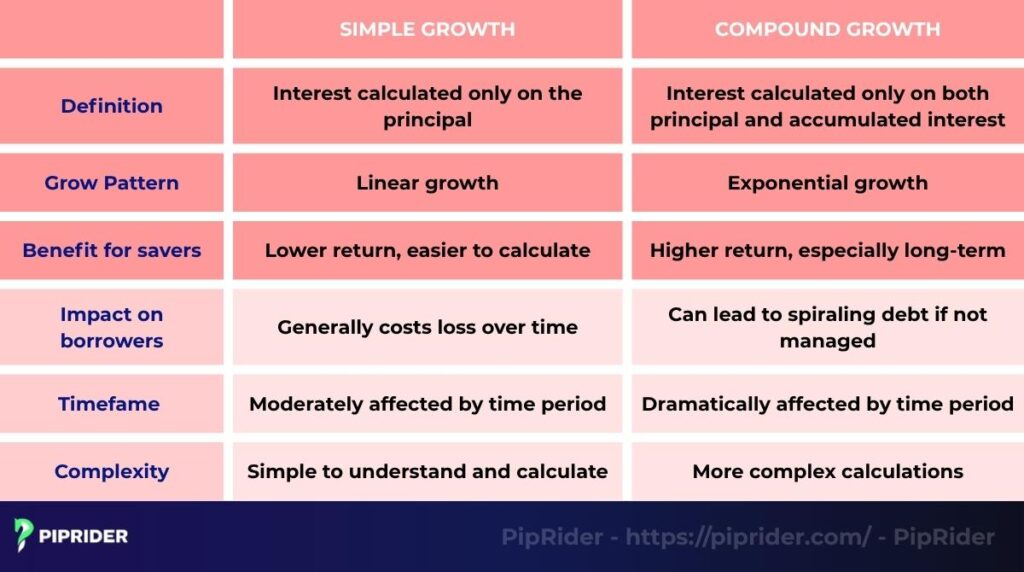
To understand its power, it’s important to see the difference:
- Simple Growth: A trader earns a return only on their initial capital. If an account starts with $1,000 and makes 10% per month but the profit is withdrawn each time, the trader will always make $100 per month. Growth is linear.
- Compound Growth: A trader earns a return on their initial capital plus their accumulated rewards. If an account starts with $1,000 and makes 10%, the new balance is $1,100. The next 10% gain is calculated on this larger amount, earning $110, and so on. Growth is exponential.
2.2. The Long-Term Impact on a Trading Account
The long-term impact of compounding on an account can be significant. While initial growth is slow, the process creates a “snowball effect.” Over many periods, consistent reinvestment can lead to exponential growth that is mathematically impossible to achieve with a simple, linear profit-taking approach.
Here is a simple comparison:
| Period | Simple Growth (10% on $1,000) | Compound Growth (10% on Balance) |
| Start | $1,000 | $1,000 |
| Month 1 | +$100 (Balance $1,100) | +$100 (Balance $1,100) |
| Month 2 | +$100 (Balance $1,200) | +$110 (Balance $1,210) |
| Month 3 | +$100 (Balance $1,300) | +$121 (Balance $1,331) |
3. How to Calculate Forex Compounding Profit
Calculating compounding profit can be done manually with a formula, but it’s far easier to use a dedicated forex compound tool. Both methods rely on the same key inputs.
3.1. The Key Inputs
To calculate potential growth, a trader must define four key variables:
- Starting Balance: The initial amount of capital in the account.
- Expected Return % (per period): The consistent percentage gain a trader aims to achieve. This should be a realistic number based on backtesting a strategy.
- Number of Periods: The total number of periods a trader wants to project (e.g., 12 months, 52 weeks).
- Compounding Frequency: How often the profit is reinvested (e.g., daily, weekly, monthly). This is a crucial input for a forex daily compound calculator.
3.2. The Basic Formula
The standard mathematical formula for calculating compound interest, which is the engine behind any trading compounding tool, is:
| A = P(1+r/n)^(n*t) |
Where:
- A = The future value of the investment, including interest.
- P = The initial principal balance (starting capital).
- r = The annual interest rate (expected percentage return, in decimal form).
- n = The number of times that interest is compounded per year (e.g., 12 for monthly, 52 for weekly).
- t = The number of years the money is invested for.
3.3. How to Use Forex Compound Calculator (A Demo)
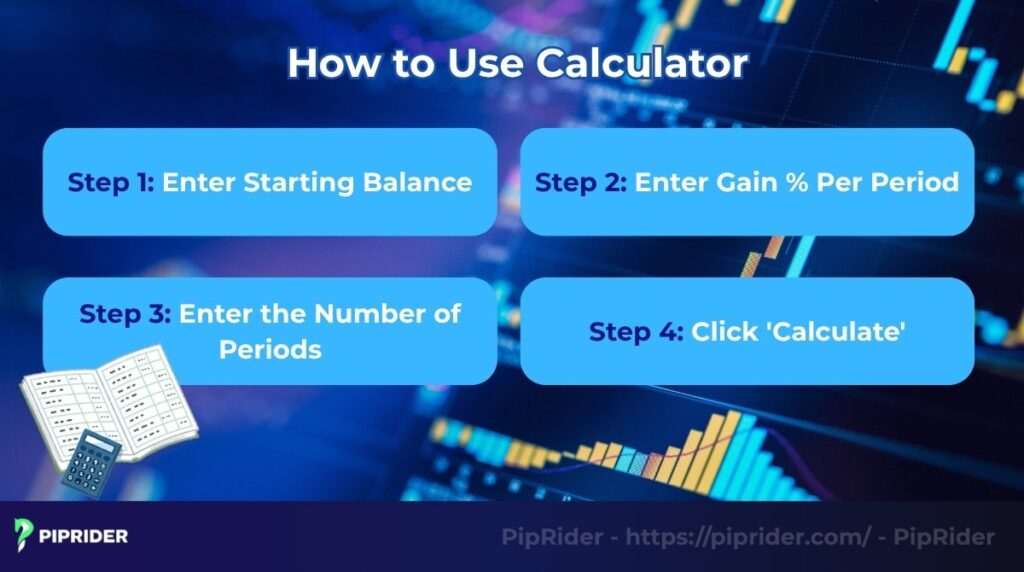
Using compounding calculator trading tools is much simpler. Here’s how:
- Enter Starting Balance: Input the initial capital (e.g., $1,000).
- Enter Gain % Per Period: Input the realistic monthly gain (e.g., 5%). This is a key step for any trading percentage calculator.
- Enter the Number of Periods: Input how many months to forecast (e.g., 24).
- Click ‘Calculate’: The tool will instantly generate a chart and a table showing the projected account growth, including the final balance and total profit.
4. Example Forex Compound Calculations
To see how the formula works in practice, let’s apply it to two different trading scenarios.
4.1. Example 1: A $1,000 Account with a 5% Monthly Return over 12 Months
In this scenario, we define the variables for our formula as follows:
- P = $1,000
- r = 60% (5% per month * 12 months)
- n = 12
- t = 1
Applying the formula:
- A = 1,000*(1+0.60/12)(12*1)
- A = 1,000*(1.05)12
- A ≈ 1,795.86
After 12 months, the account would grow to approximately $1,795.86.
4.2. Example 2: A $5,000 Account with a 2% Weekly Return over 6 Months
Here, we define the variables differently:
- P = $5,000
- r = 104% (2% per week * 52 weeks)
- n = 52
- t = 0.5 (6 months)
Applying the formula:
- A = 5,000*(1+1.04/52)^(52*0.5)
- A = 5,000*(1.02)^26
- A ≈ 8,367.79
After 6 months (26 weeks), the account would grow to approximately $8,367.79.
A Clear Comparison
This table illustrates the dramatic long-term difference between reinvesting profits (compounding) and withdrawing them (simple return), using the first example ($1,000 account, 5% monthly return).
| Month | Compounding Balance | Simple Return (Profit Withdrawn) |
| Start | $1,000 | $1,000 |
| 3 | $1,157.63 | $1,150 |
| 6 | $1,340.10 | $1,300 |
| 12 | $1,795.86 | $1,600 |
5. Why a Trader Should Use a Forex Compound Tool
The Forex Compound tool is not just for seeing large numbers; it is an essential instrument for professional planning and strategy development. Here’s why it’s so important:
- Creating realistic profit plans: The calculator allows a trader to set tangible, long-term goals. By inputting a realistic monthly return, a trader can visualize a clear path to growing their account, which is far more effective than aiming for random, unrealistic rewards.
- Shaping a trader’s capital management strategy: The tool helps a trader understand the powerful impact of consistency. Seeing how even small, steady gains can grow over time reinforces the importance of protecting capital and avoiding high-risk trades that could derail the compounding process.
- Maintaining discipline and realistic expectations: The compounding curve shows that growth is slow at the start. This visual forecast helps a trader maintain patience and discipline during the early stages. It also sets reasonable expectations, preventing the frustration that comes from expecting immediate, exponential earnings.
6. Forex Compound Calculator and Trading Strategies
A forex compound tool is not a trading strategy in itself. To use it effectively, the concept of compounding must be integrated with your practical trading approach.
6.1. Combining Compounding with Risk Management
The two concepts are inseparable. A trader should only consider their “gain %” for the calculator as the profit made after adhering to strict risk management rules (like the 1-2% rule). The goal is to compound small, consistent, low-risk gains, not to chase high returns with high risk, which will inevitably break the compounding chain.
6.2. Adjusting Compounding Based on Trading Style
The frequency of compounding depends on a trader’s style:
- Scalping/Day Trading: These traders might aim for a small daily or weekly reinvestment goal, as they have many trades and a faster feedback loop.
- Swing Trading/Long-Term Trading: These traders will have fewer trades and should use a monthly or quarterly compounding period. Trying to reinvest on a daily basis is unrealistic for this style.
6.3. Tips to Avoid Unrealistic Expectations
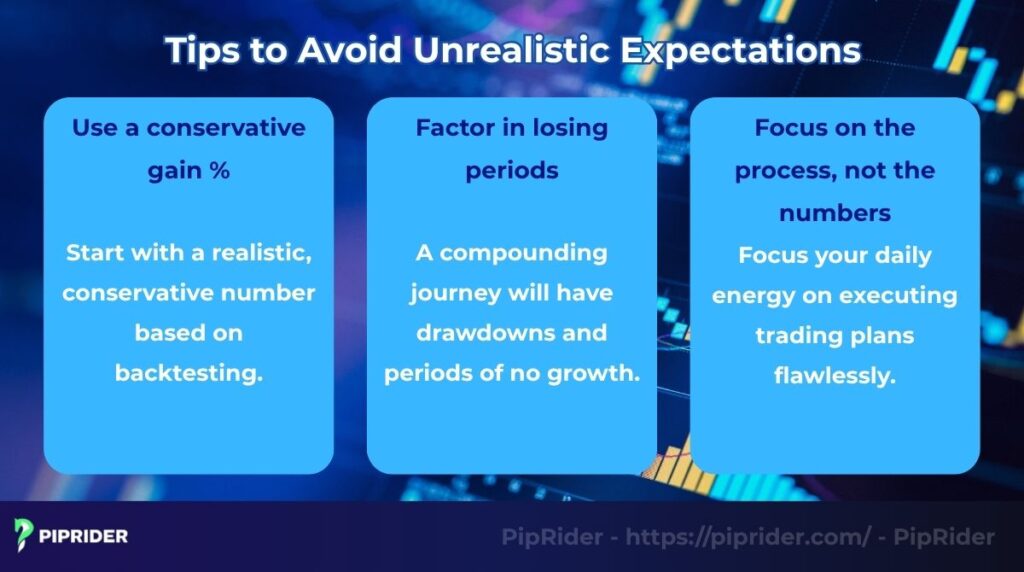
The biggest danger of this tool is that it can create unrealistic expectations. Here are some tips to stay grounded:
- Use a conservative gain %: Do not input a 20% or 30% monthly gain. Start with a realistic, conservative number based on backtesting (e.g., 2-5% per month).
- Factor in losing periods: No strategy wins every month. Remember that a compounding journey will have drawdowns and periods of no growth.
- Focus on the process, not the numbers: Use the tool for long-term motivation, but focus your daily energy on executing trading plans flawlessly.
7. Frequently Asked Questions (FAQs)
8. Conclusion
In conclusion, the forex compound calculator is an essential tool that powerfully illustrates how small, consistent gains can transform into significant capital growth over time. It shifts a trader’s focus from short-term wins to a more strategic, long-term approach to building wealth in the forex market.
To discover more powerful instruments that can enhance your trading, we encourage you to explore our in-depth guides in the Trading Tools & Platforms category on Piprider.


